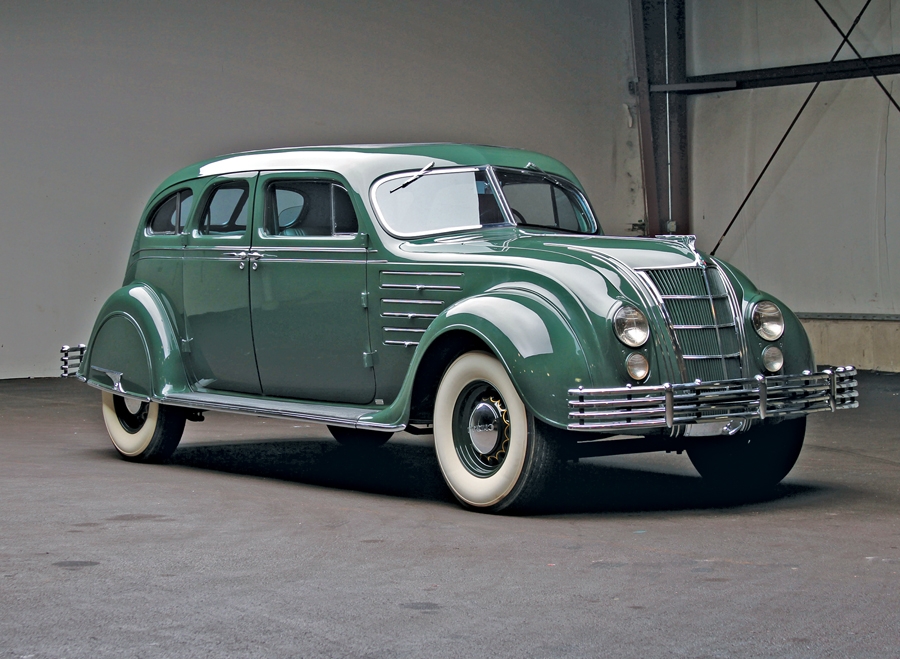The Chrysler Airflow was a brilliant and revolutionary creation with the promise of cutting-edge design and technology. Easy flowing lines swept to the rear and allowed air currents to slip by while passengers relaxed and settled into seats as big and soft as divans. Artistry of the highest order was apparent in every detail of the refreshing, new-style interior. Chrysler was proud to proclaim that the new Airflow was the result of master craftsmen working with untiring hands to set a new standard for a custom-built motorcar, endowing the model with “the atmosphere of a smart, modern penthouse.”
Credit for the Airflow is properly given to engineer Carl Breer, who with Owen Skelton and Fred Zeder, formed Chrysler’s “Three Musketeers.” The streamlined shape was the result of groundbreaking wind-tunnel research with the assistance of aviation expert Orville Wright to study which forms were the most efficient shapes in nature that could be suitable for an automobile. Chrysler called it “the first real motorcar.” It was an engineering triumph, incorporating a combination of features rare when the Airflow was introduced, but eventually to become commonplace in automotive design.
Having received a full rotisserie restoration, this rare Airflow is concours-quality. The body, paint, chrome, brightwork and glass are all in excellent condition. Similarly, the soft green leather upholstery and interior is absolutely exquisite. It would be difficult to locate and purchase a finer example of the acclaimed Chrysler Airflow.
SCM Analysis
Detailing
| Vehicle: | 1934 Chrysler Custom Imperial CX Airflow |
| Number Produced: | 106 1934 CXs |
| Original List Price: | $2,345 |
| Tune Up Cost: | $250 |
| Distributor Caps: | $35 |
| Chassis Number Location: | Plate on right door hinge |
| Engine Number Location: | Upper left of cylinder block |
| Club Info: | Airflow Club of America |
| Website: | http://www.airflowclub.com |
| Investment Grade: | B |
This car, Lot 5114, was offered from the John Scotti Collection and sold for $213,400, including buyer’s premium, at Auctions America Spring sale in Auburn, IN, on May 8–10, 2014.
Innovation often comes with a price. The initial idea, regardless of the benefit, is often ignored as too radical or different. Success only comes later as others pick up the fallen torch.
That was certainly the case with the Chrysler Airflow.
The car offered increased safety and performance — along with a quieter and more comfortable ride. Only 11,016 Airflows were sold in 1934, as the car was viewed as too different and radical. Sales continued to fall, with only 4,610 Airflows sold in 1937, when Chrysler threw in the towel. Today, however, the aerodynamic shape of modern automobiles can be traced to the Airflow’s initial development.
Engineer Carl Breer and his team, with the assistance of Orville Wright, built a basic wind tunnel and tested the air resistance on various shapes of wooden car models. They determined that the resistance was lessened when the cars faced away from the wind. In other words, they were more efficient when driven backwards! They determined that by moving the weight forward, the car would displace more air and it would move more smoothly around the car. As a side benefit, when they moved the rear seat to a position ahead of the axle, the rear passengers enjoyed a smoother, roomier ride.
A prototype, called the Trifon, was constructed in secret and incorporated these novel design features including a monocoque — unibody — metal frame that supported the body. This was at a time when many manufacturers were still using wood body frames.
Cliff-jumping stunts
As an aside, Chrysler, as a promotional stunt to demonstrate the strength of the frame, rolled an Airflow off a cliff and drove it away under its own power. Well, on the second attempt they drove it away. On the first try, the car landed on its top.
Walter Chrysler shared his engineering team’s excitement for the car, and he ordered it into production not only as a DeSoto but also as a Chrysler that would be part of Chrysler’s 10th anniversary celebration.
The Airflow was introduced at the New York National Auto Show in January of 1934, and the car “That literally Bore a Hole through the Air” was ordered by the thousands. Production issues, however, delayed deliveries, so buyers turned elsewhere. Breer pointed to these delays as the reason for the poor sales, but enthusiasm waned even with extensive promotion.
The 1934 Chrysler Airflow was offered in three series: the Model CU or Airflow Eight, the Airflow Imperial CV and the Custom Imperial CX and CW with a 137- and 146-inch wheelbase. They were all fitted with 8-cylinder engines — and the massive, sloped waterfall grille that extended into the hood.
A modified grille
Dealers often updated 1934 Airflows with the more sedate grill that was introduced in 1935. That was the case with our subject car. The car also was finished in a stunning shade of green. While this was not a color offered by the factory, it could have conceivably been obtained via special order. The interior was finished with contrasting green leather in the front and broadcloth in the rear. It was fitted with four-bar bumpers, which were correct for the CW cars — but not the CX presented here.
A record sale
The Chrysler Airflow CW and CX have Full Classic status, and some additional Airflow series have recently been granted the same status. This should have a positive effect on future values, although our subject car has been offered for some time at a figure close to $250,000.
Only 106 CX Airflows were produced, and 78 of them were 6-passenger limousines, making this a very rare car. Nonetheless, the price paid here was certainly aggressive and is a high-water mark for the much maligned Chrysler Airflow. Well sold — for now. ♦
(Introductory description courtesy of Auctions America.)
